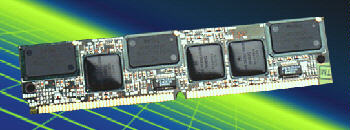Home :: Products & Services
:: Hardware:: Modules
:: DSP Modules
Sig563xx Multiprocessor DSP Modules
OverviewThe Sig563xx SIMM modules provide multi-processor DSP solutions for telecommunications and internet routing infrastructure applications. These modules are low-cost, high-performance, and provide several advantages for OEM products:
Module DescriptionsThe Sig563xx SIMM modules each can be populated with one to six 100 MHz 56303, 56309, or 56307 DSPs and one to six 128k x 24 SRAM devices, or up to ten 56311 devices (each with 128k x 24 onchip SRAM). The offchip SRAM devices provide variable configuration of 64k x 24 of offchip X: or Y: data memory, and 64k x 24 of offchip P: program memory. JTAG signals are chained between DSPs and brought out to the module edge connector. The Sig563xx SIMM modules are fully supported by the following off-the-shelf software development packages: The DirectDSP sofware includes support for popular host programming environments, including MATLAB, C/C++ (MSVC and Borland), Visual Basic, and LabVIEW. See Software Support below for more information. Specifications and Data Sheets
Development SystemThe Sig563xx development system includes:
a high-speed host-interface card which connects to the development platform via 37-pin ribbon cable, and provides multiprocessor interface to the DSP modules using Motorola's 563xx "HI08" format. One or more combination of DSPs can be controlled simultaneously, and accessed simultaneously on writes (broadcast mode), and individually on reads. Broadcast mode includes program (COFF) file download, reset, and run. development system software, including DirectDSP and Real-Time Composer™ software, which provide:
Software SupportSig563xx modules, as well as other 563xx platforms such as the EVM563xx series of boards, are supported by Signalogic off-the-shelf DSP software products designed for DSP-based data acquisition and 563xx DSP code development, including: Hypersignal®-Macro and Hypersignal-Acoustic software series, which offer a number of simulation and real-time instrument functions. Simulation functions include DSP and math functions, time domain display (including waterfall, contour, magnitude, unwrapped phase), difference equation, digital FIR and IIR filter design, sampling rate conversion, frequency zoom, wavelet transform, minimum phase calculation, and many more. Instrument functions include: spectrum analyzer, digital oscilloscope, stimulus & response measurement, continuous signal generation, real-time "snap-in" filtering, continuous disk record and generate, and more.DirectDSP® is a Windows library which provides low-level and high-level calls for user-defined C/C++, Visual Basic, MATLAB®, or LabVIEW® programs. DirectDSP includes low-level board control functions such as reset/run/hold, register access, block memory transfer, DSP executable file download, etc. High-level functions include waveform file acquire/generate, continuous signal generation, and execution of any arbitrary Hypersignal DSP or math function. DirectDSP includes strip-chart recorder, digital oscilloscope and digital tape recorder demo program and source code examples. The DSP56xxx Source Code Interface contains numerous 563xx algorithms and functions in source and binary form, such as optimized FFTs, filters, matrix, transcendental, trig, signal manipulation function, board initialization and analog I/O examples, etc. These functions form the basis of higher-level software functions and instruments; modification can be used to customize Hypersignal or DirectDSP operation. User-defined C routine hooks are provided for real-time algorithm development. The DSP563xx Source Code Interface can be used as a basic foundation for user-defined real-time DSP systems and products. Real-Time Composer™ is a Windows program which offers a block-diagram based design environment that allows both block-diagram simulation and interactive display and instrument functions, including control over individual Hypersignal and MATLAB blocks. The Real-Time Composer™ includes complete visual IDE for Motorola development tools, and allows C source code generation from block diagram, with generated programs compiled and downloaded to the Sig563xx modules for real-time execution. |




